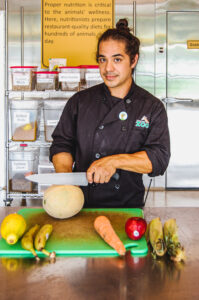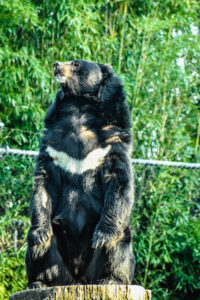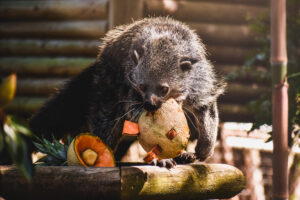Don’t Feed Me
The Zoo has a set of important safety rules we ask each visitor to follow. These are for the safety of everyone; guests, staff and volunteers, and for our animals! One rule, in particular, is most important to the animals – not feeding them or throwing items in their exhibit. This may come as a surprise to you, but Zoo Keepers, staff and volunteers have found everything from sunglasses and pacifiers to shrink-wrapped vegetables and even plastic-wrapped raw ribs in the animals’ exhibits! Items such as these that weren’t purposely given by Keepers can be unsafe for the animals for a variety of reasons.
The animals have a specialized diet.
While you may see human food in some animal’s exhibits – such as fresh fruits and vegetables – this doesn’t mean they eat the same food as us. An animal’s food is carefully selected, cleaned, weighed and tracked by their Zoo Keepers to document their diets. Zoo Keepers report even the slightest change in an animal’s eating habits to the Veterinarian as it could be cause for a checkup. Each species has a specific set of dietary needs, and some animals have very specialized diets. Many of the animals not only have specific fruits, vegetables, meats, grains nuts that they need to eat for proper nutrition, but some animals require steamed produce or bones removed from their meat due to aging or pre-existing medical conditions. Additionally, many foods that are safe for humans to eat can be highly toxic to some of our animals species. Therefore, providing any outside food, including human food, beyond an animal’s diet not only puts them at risk for illness, but it can also put them in danger.
While you may think an animal appears to be hungry, we can assure you they are receiving the proper nutrition, calories and professional care from our staff. Each animal’s diet at the Zoo is strictly monitored and made specifically for that animal. Animal diets and amounts have been formulated with approval from our Veterinarian, as well as with input from a consulting Board Certified Zoo Nutritionist and from information gathered based on years of research by fellow zoological colleagues and our accrediting organization, the Association of Zoos and Aquariums. Animal weights and body conditions are monitored closely by Keeper and Veterinary staff and diet amounts may be adjusted as needed to keep the animals as healthy as possible.
You may see animals foraging, or digging around for food in the ground, trees or toys, but the animals are not hungry. Sometimes they are seeking out enrichment items that have been placed there intentionally for the animals and may not be obvious to the visitor’s eye. For instance, the Keepers will sometimes wipe honey or bury food items around the moon and sun bear exhibits so you may see Chai, Thai or Palu digging at or licking mounds of substrate, trees or stumps. Foraging for food is a natural behavior for bears and many other species at the Zoo, and the challenge of sniffing out and excavating part of their diets can be very enriching for the animals. These enrichment food items are also carefully calculated into their overall diet.
Please remember, that while the Zoo is a fun place for humans to visit, it also needs to be a safe environment for our animals. Anyone caught feeding an animal at the Zoo will be escorted off Zoo grounds and not be given a refund. No exceptions. Thank you for helping to keep our animals safe and let’s continue to do what we do best, protect our wildlife here at the Zoo and save their counterparts in the wild.


